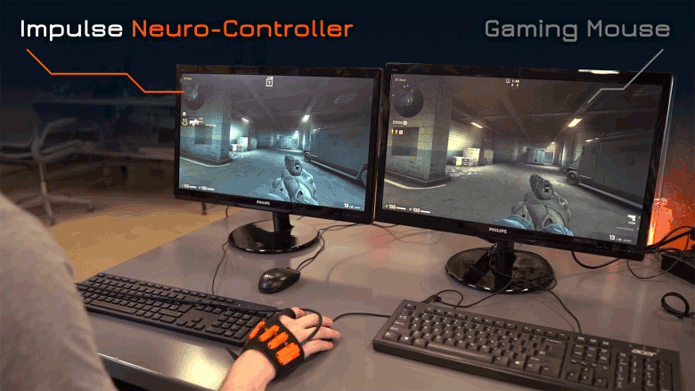# OnThisDay 1979: On the 10th anniversary of the first moon landing, James Burke went to NASA, to reflect on the heart-stopping minutes preceding “The eagle has landed.”


# OnThisDay 1979: On the 10th anniversary of the first moon landing, James Burke went to NASA, to reflect on the heart-stopping minutes preceding “The eagle has landed.”



George Will, a political commentator for nearly half a century at The Washington Post, is known to also enjoy weighing in on sports on occasion, most notably baseball. He is fond of repeating the simple but critical observation that these games are a matter of “seconds and inches.”
In digital games, the same maxim applies, but even more so. Fractions of inches matter when targeting the enemy. And critical time is not measured in seconds but in thousandths of seconds.
With that in mind, developers at Canadian startup Brink Bionics have developed a device that promises to boost gamer proficiency by slashing the delay time between an intent to act and execution of the actual action.



Researchers develop the first nanomaterial that demonstrates “photon avalanching;” finding could lead to new applications in sensing, imaging, and light detection.
Researchers at Columbia Engineering report today that they have developed the first nanomaterial that demonstrates “photon avalanching,” a process that is unrivaled in its combination of extreme nonlinear optical behavior and efficiency. The realization of photon avalanching in nanoparticle form opens up a host of sought-after applications, from real-time super-resolution optical microscopy, precise temperature and environmental sensing, and infrared light detection, to optical analog-to-digital conversion and quantum sensing.
“Nobody has seen avalanching behavior like this in nanomaterials before,” said James Schuck, associate professor of mechanical engineering, who led the study published today (January 132021) by Nature. “We studied these new nanoparticles at the single-nanoparticle level, allowing us to prove that avalanching behavior can occur in nanomaterials. This exquisite sensitivity could be incredibly transformative. For instance, imagine if we could sense changes in our chemical surroundings, like variations in or the actual presence of molecular species. We might even be able to detect coronavirus and other diseases.”

Compared to standard machine learning models, deep learning models are largely superior at discerning patterns and discriminative features in brain imaging, despite being more complex in their architecture, according to a new study in Nature Communications led by Georgia State University.
Advanced biomedical technologies such as structural and functional magnetic resonance imaging (MRI and fMRI) or genomic sequencing have produced an enormous volume of data about the human body. By extracting patterns from this information, scientists can glean new insights into health and disease. This is a challenging task, however, given the complexity of the data and the fact that the relationships among types of data are poorly understood.
Deep learning, built on advanced neural networks, can characterize these relationships by combining and analyzing data from many sources. At the Center for Translational Research in Neuroimaging and Data Science (TReNDS), Georgia State researchers are using deep learning to learn more about how mental illness and other disorders affect the brain.
Symbiosis by combining humans with artificial intelligence is Elon Musk’s #Neuralink corporate goal and I agree that is a great strategy for the future and why he is the richest person in the world now. 🌎
Some smart robots can perform complex tasks on their own, without the programmers understanding how they learned them.

As the story goes, the Greek mathematician and tinkerer Archimedes came across an invention while traveling through ancient Egypt that would later bear his name. It was a machine consisting of a screw housed inside a hollow tube that trapped and drew water upon rotation. Now, researchers led by Stanford University physicist Benjamin Lev have developed a quantum version of Archimedes’ screw that, instead of water, hauls fragile collections of gas atoms to higher and higher energy states without collapsing. Their discovery is detailed in a paper published Jan. 14 in Science.
“My expectation for our system was that the stability of the gas would only shift a little,” said Lev, who is an associate professor of applied physics and of physics in the School of Humanities and Sciences at Stanford. “I did not expect that I would see a dramatic, complete stabilization of it. That was beyond my wildest conception.”
Along the way, the researchers also observed the development of scar states—extremely rare trajectories of particles in an otherwise chaotic quantum system in which the particles repeatedly retrace their steps like tracks overlapping in the woods. Scar states are of particular interest because they may offer a protected refuge for information encoded in a quantum system. The existence of scar states within a quantum system with many interacting particles—known as a quantum many-body system—has only recently been confirmed. The Stanford experiment is the first example of the scar state in a many-body quantum gas and only the second ever real-world sighting of the phenomenon.